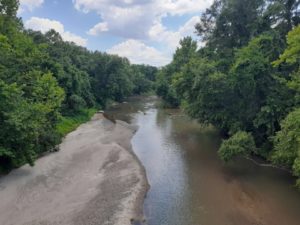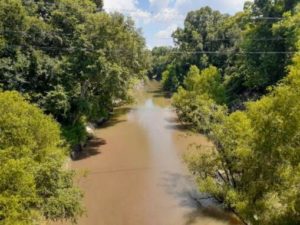Report by Charles Williams, 2nd VP for Louisiana Wildlife Federation
I became a Comite River fan in 1971 when I was a grad student at LSU and living in Baton Rouge’s Spanish Town. On weekends I would frequently head north to one of Comite River’s many possible put-in points and paddle for a few hours or all day. This was just a year or so after the Louisiana Legislature created a statewide scenic rivers system with the goal of “preserving, protecting, developing, reclaiming, and enhancing the wilderness qualities, scenic beauties, and ecological regimes of certain free-flowing Louisiana streams.” Due to the lower section of the river not meeting the basic requirements of the designation at that time, the Comite’s scenic river status was established as beginning where White Bayou enters the river just south of Comite Drive and continuing from there to Highway 10 just west of Clinton.
In 2008, after living out of state for more than three decades, I moved back to the Baton Rouge area as a retiree with a kayak and one of my first impulses was to paddle the Comite. I did so, but wow had things changed. The development booms of the Zachary and Central areas, suburban sprawl in general, and an invasion of ATVs treating the river bottom and privately owned banks as ATV trails had done a number on the river. Stream banks and bottoms were rutted and eroded by the ATVs, which had not been a thing when Louisiana’s Scenic River program was established. Trash from the partying ATVers was everywhere as scores of “river riders” would infest the river every weekend.
By 2010 it was recognized that ATV riding in scenic rivers was contrary to protection of the rivers for their ecological and scenic values and should be prohibited. In 2011 LWF Board adopted a resolution to that effect, thus initiating a two-year battle involving multiple public hearings before the Louisiana Wildlife and Fisheries Commission (LWFC). LWF led this fight, recruiting allies along the way from the ranks of birding clubs, paddling clubs, chapters of national environmental groups, civic clubs, unhappy landowners whose sandbars were being trampled and littered, and scores of individuals who were concerned about this activity spreading to other designated scenic rivers, which was actually happening on several other rivers in southeast and southwest Louisiana. This battle was finally won in 2013 when the LWFC adopted a rule to ban ATVs from scenic rivers. Within a year or two, the river returned to its previous status as a quiet, mostly shaded stream suitable for all levels of paddling experience. Fishing for spotted bass improved greatly as the disturbance and sedimentation caused by the ATV users receded and the bass population recovered.
Then the terrible floods of 2016 came, caused by (depending on whose estimate you accept) either a 500 year flood or a 750 year flood event. Just about any house even vaguely in the Comite River floodplain (as well as the Amite River’s) flooded with anywhere from a foot to eight feet of water. This disaster, of course, led to much finger pointing about why flood control measures that had been on the docket for decades, especially the Comite River Diversion Canal Project, had never been implemented.
Construction of the diversion canal is now underway as well as a variety of smaller, localized steps including cleanout of streams, bayous, and ditches that are tributaries to the Comite. In May of this year, a contractor began desnagging the river to improve flow during high water stages. The first phase of the desnagging will proceed to Highway 64 east of Zachary just north of where the Comite River Diversion Canal, upon completion, will exit the river. All fallen trees in the river are being removed as well as some trees that appear to have the potential to fall due to bank erosion. The channel is not being dug out or straightened but the work is substantial and is greatly changing, at least temporarily, the hydrology, ecology and appearance of the river.
 The photos that accompany this report were taken from various Comite bridge crossings in early June 2023 at Joor Road or above, prior to desnagging activities. The shady river with logs along the banks and jutting out into the river is now being replaced by a river with clean, cleared banks, muddy water, and much less shade. No doubt this will damage the fish population and one has to wonder about the future of the bass which had become much more numerous in recent years. With cover and shade reduced as well as populations of bass prey species, will the Comite still provide the quality of fishing we’ve had in recent years? Will the shady float trip of the past be replaced by floats on what appears more like a ditch or canal than a river? Will the bald eagles that I’ve regularly seen patrolling the river leave the vicinity because of a decline in the fish population which they subsist on?
The photos that accompany this report were taken from various Comite bridge crossings in early June 2023 at Joor Road or above, prior to desnagging activities. The shady river with logs along the banks and jutting out into the river is now being replaced by a river with clean, cleared banks, muddy water, and much less shade. No doubt this will damage the fish population and one has to wonder about the future of the bass which had become much more numerous in recent years. With cover and shade reduced as well as populations of bass prey species, will the Comite still provide the quality of fishing we’ve had in recent years? Will the shady float trip of the past be replaced by floats on what appears more like a ditch or canal than a river? Will the bald eagles that I’ve regularly seen patrolling the river leave the vicinity because of a decline in the fish population which they subsist on?
Local elected officials sought approval from the state legislature in 2018 for the Comite River to be suspended from the protections of a Louisiana Scenic River designation until 2021 and subsequently asked for an extension until 2026. Will the desnaggings become a regular procedure in the next few years, thereby eliminating much of the scenic and recreational value of this once rural but now suburban river?
At LWF we recognize the need for improved flood management in the Amite/Comite system and that a stable river system plays a crucial role. We hope the desnagging and other flood control measures are conducted in a way that preserves as much of the Comite’s natural river values as possible. For now it’s been suspended from the requirements of the system as the flood control engineers do their thing. When all is said and done, maybe it can recover and maybe not.
 We hope that BREC (Baton Rouge’s award-winning parish recreation system) and other agencies with land on the river will start taking steps to implement the “Blueways” plan of improved access for the public via small boat landings for paddlers as has been done on some bayous in south Baton Rouge. The Comite River is a valuable community asset for more than simply drainage. It’s possible that we could eventually have a satisfactory compromise between necessary flood management measures and the recreational and ecological values that the scenic river system was designed to protect.
We hope that BREC (Baton Rouge’s award-winning parish recreation system) and other agencies with land on the river will start taking steps to implement the “Blueways” plan of improved access for the public via small boat landings for paddlers as has been done on some bayous in south Baton Rouge. The Comite River is a valuable community asset for more than simply drainage. It’s possible that we could eventually have a satisfactory compromise between necessary flood management measures and the recreational and ecological values that the scenic river system was designed to protect.
Stand by for photos of the river after the desnagging.
-Charles Williams


Comments are closed.